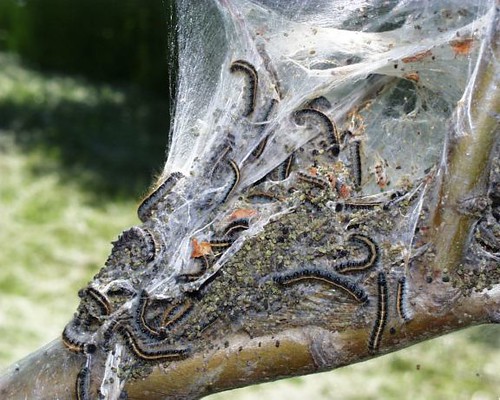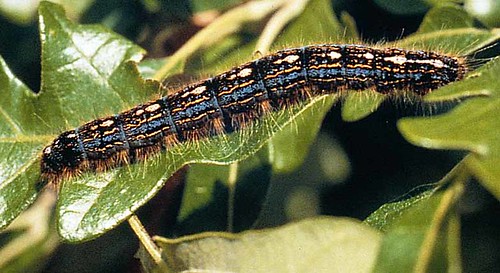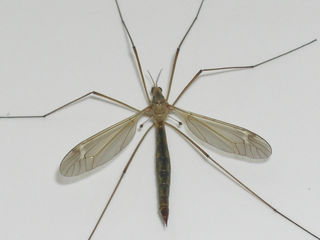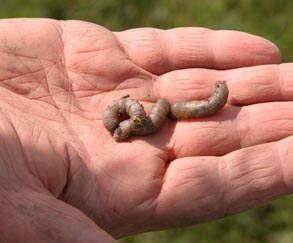
5:40 p.m. - 2007-05-22
Fly and Caterpillar
Howdy, Critter Fans!
I hope you've been having a great week!
Things are good here. Pink rosebuds have begun to unfurl outside of my animal temp job, and will keep blossoming until the fall.
This weekend R and I went to the Motherland to celebrate the wedding of my beautiful cousin, JS.
As we drove, we spotted the silk nests of tent caterpillars! Earlier last week I saw a huge mass of these same worms on a tree trunk near our running path.
The other insect we encountered in WI was indoors, at our favorite restaurant. As we enjoyed our gourmet breakfasts, TG, the fiance of my sister A, noticed a large flying insect alighting near the salt and pepper shakers. TG crushed the invader with a spare fork!
And a Double Creature Feature was born.
First, the tent caterpillar! Malacosoma americanum:
These bugs hang out in North America, Mexico and Eurasia. They eat young tree leaves, often orchard trees, and can kill small or already weakened trees.
In March, clusters of caterpillar eggs hatch. They start eating leaves and begin spinning their silk nest. This nest protects them from cold temperatures and provides a warm place for them to digest their food. A tent can be up to 30 degrees warmer inside than the cool morning air. In hot or wet weather the caterpillars will emerge at night to feed.
Predators are also thwarted by the silk tent. These enemies include birds and many species of tiny wasps.
"Ew, Gross!" section: In heavily infested trees, the sound of falling caterpillar droppings can be confused for rainfall!
Tent caterpillars are important scientifically as they are one of the most social of moth larvae. They stay together as siblings and even leave pheromone trails for each other to find as they explore different areas of the tree for leaves. These trails lead them to good food, as well as back to the safety of the tent.
After six to eight weeks of growth, or until the caterpillars grow to two to two and a half inches long, they will leave the tree. (And crawl over everything in the process.) Then they wrap a silk cocoon around themselves, and emerge three weeks later as a moth: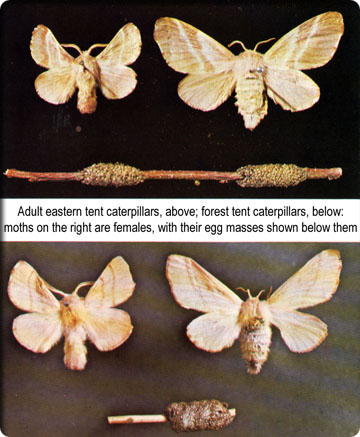
The female moth then secretes some love pheromones, and males flock to her to fertilize her eggs. She lays them on a tree, within a foam-like substance, which keeps them hydrated and will protect the eggs in frigid winter temperatures. Then the female moth dies, while the male might live a week longer.
Apparently it is easier to kill the tent caterpillar when it is in its egg stage, as the tent will protect the worms somewhat from pesticides.
And now for the "giant mosquito" we saw in the restaurant!
Yikes! This is a Crane Fly, part of the family Tipulidae, which is the largest branch of the giant Diptera, or fly family.
There are about 14,000 species of these guys around the world. They're also called jimmy spinners, golly hoppers, gallon nippers, skeeter eaters or mosquito hawks. In the United Kingdom they're known as daddy longlegs, and in France are called cousins. Hmmm.
In truth, crane flies are totally harmless. If they eat anything at all as adults, it is nectar. Most adult crane flies don't actually eat, existing only to breed.
Many crane flies live around water, laying eggs near it or under the surface. Crane fly larvae are called leather jackets, and are mysterious to scientists as most haven't been positively identified. The larvae are an important food source for underwater creatures, as well as birds and small mammals on land.
The larvae also cause problems to humans. Some imported European species of crane flies will eat turf roots, potentially damaging lawns. This seems to be a problem in the Pacific Northwest.
Crane flies can grow up to two and a half inches long, with a wingspan of three inches or more. Females have fatter bodies as their abdomens are filled with eggs.
Note the tiny "second wings" behind the larger ones. These halteres move like gyroscopes and provide balance for flight. "Haltere" is apparently the French word for "barbell", which implies its counterweight purpose.
Crane flies are weak flyers, moving in a halting, zig-zagging path. Scientists think this might be to prevent birds from catching them. The long legs help it land in grass, the better to lay eggs, or pursue nooky.
So, there you have it. Two insects that have proven to be much more interesting than I first thought.
Watch out for falling tent caterpillar poo!
XOXO,
Wendell!


